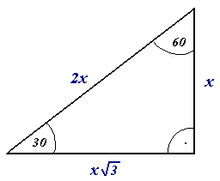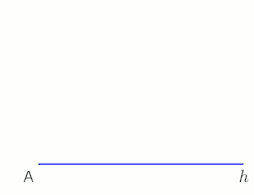Right Angle In A Square

A right angle is equal to 90 degrees.

A line segment (AB) drawn so that it forms correct angles with a line (CD).
In geometry and trigonometry, a correct angle is an angle of exactly 90 degrees or / 2 radians[1] corresponding to a quarter plow.[2] If a ray is placed and then that its endpoint is on a line and the adjacent angles are equal, then they are right angles.[3] The term is a calque of Latin angulus rectus; here rectus means "upright", referring to the vertical perpendicular to a horizontal base line.
Closely related and important geometrical concepts are perpendicular lines, pregnant lines that form right angles at their signal of intersection, and orthogonality, which is the belongings of forming right angles, unremarkably applied to vectors. The presence of a correct bending in a triangle is the defining gene for correct triangles,[4] making the correct angle basic to trigonometry.
Etymology [edit]
The meaning of right in correct angle perchance refers to the Latin adjective rectus 'erect, directly, upright, perpendicular'. A Greek equivalent is orthos 'straight; perpendicular' (see orthogonality).
In elementary geometry [edit]
A rectangle is a quadrilateral with iv right angles. A square has four right angles, in add-on to equal-length sides.
The Pythagorean theorem states how to decide when a triangle is a correct triangle.
Symbols [edit]

Right triangle, with the correct angle shown via a small square.

Another option of diagrammatically indicating a right angle, using an bending curve and a small-scale dot.
In Unicode, the symbol for a correct angle is U+221F ∟ Right Angle (∟). Information technology should non be confused with the similarly shaped symbol U+231E ⌞ Bottom LEFT CORNER (⌞, ⌞). Related symbols are U+22BE ⊾ RIGHT Bending WITH ARC (⊾), U+299C ⦜ RIGHT ANGLE VARIANT WITH SQUARE (⦜), and U+299D ⦝ MEASURED RIGHT Angle WITH DOT (⦝).[5]
In diagrams, the fact that an angle is a right angle is usually expressed by adding a small right angle that forms a square with the angle in the diagram, equally seen in the diagram of a right triangle (in British English, a right-angled triangle) to the right. The symbol for a measured angle, an arc, with a dot, is used in some European countries, including High german-speaking countries and Poland, as an alternative symbol for a right bending.[6]
Euclid [edit]
Right angles are fundamental in Euclid's Elements. They are defined in Volume ane, definition 10, which too defines perpendicular lines. Definition x does not use numerical degree measurements but rather touches at the very middle of what a right angle is, namely two straight lines intersecting to form two equal and adjacent angles.[7] The direct lines which grade right angles are called perpendicular.[8] Euclid uses right angles in definitions 11 and 12 to define astute angles (those smaller than a right angle) and birdbrained angles (those greater than a right bending).[9] Two angles are called complementary if their sum is a correct angle.[10]
Volume 1 Postulate 4 states that all right angles are equal, which allows Euclid to utilize a right angle as a unit to measure other angles with. Euclid's commentator Proclus gave a proof of this postulate using the previous postulates, but it may be argued that this proof makes use of some hidden assumptions. Saccheri gave a proof as well just using a more than explicit assumption. In Hilbert'south axiomatization of geometry this argument is given every bit a theorem, but just after much groundwork. I may argue that, even if postulate iv can exist proven from the preceding ones, in the social club that Euclid presents his material it is necessary to include it since without information technology postulate 5, which uses the right angle equally a unit of measurement of measure, makes no sense.[eleven]
Conversion to other units [edit]
A right angle may be expressed in different units:
- ane / 4 turn
- ninety° (degrees)
- π / 2 radians
- 100 grad (too chosen class, gradian, or gon)
- 8 points (of a 32-bespeak compass rose)
- 6 hours (astronomical 60 minutes angle)
Rule of three-4-five [edit]
Throughout history, carpenters and masons have known a quick mode to confirm if an angle is a truthful "right bending". It is based on the virtually widely known Pythagorean triple (3, 4, v) and then called the "rule of 3-4-five". From the bending in question, running a straight line forth one side exactly iii units in length, and forth the 2d side exactly 4 units in length, volition create a hypotenuse (the longer line opposite the correct angle that connects the two measured endpoints) of exactly 5 units in length. This measurement can be made rapidly and without technical instruments. The geometric law behind the measurement is the Pythagorean theorem ("The square of the hypotenuse of a right triangle is equal to the sum of the squares of the two adjacent sides").
Thales' theorem [edit]

Construction of the perpendicular to the one-half-line h from the point P (applicable not but at the end indicate A, One thousand is freely selectable), animation at the terminate with interruption 10 s

Culling construction if P outside of the one-half-line h and the distance A to P' is small (B is freely selectable),
animation at the finish with intermission 10 s
Thales' theorem states that an bending inscribed in a semicircle (with a vertex on the semicircle and its defining rays going through the endpoints of the semicircle) is a right angle.
Two application examples in which the right angle and the Thales' theorem are included (see animations).
Run across likewise [edit]
- Cartesian coordinate system
- Types of angles
References [edit]
- ^ "Right Angle". Math Open up Reference . Retrieved 26 April 2017.
- ^ Wentworth p. eleven
- ^ Wentworth p. viii
- ^ Wentworth p. 40
- ^ Unicode five.ii Character Code Charts Mathematical Operators, Miscellaneous Mathematical Symbols-B
- ^ Müller-Philipp, Susanne; Gorski, Hans-Joachim (2011). Leitfaden Geometrie [Handbook Geometry] (in German). Springer. ISBN9783834886163.
- ^ Heath p. 181
- ^ Heath p. 181
- ^ Heath p. 181
- ^ Wentworth p. 9
- ^ Heath pp. 200-201 for the paragraph
- Wentworth, Thousand.A. (1895). A Text-Book of Geometry. Ginn & Co.
- Euclid, commentary and trans. by T. L. Heath Elements Vol. i (1908 Cambridge) Google Books
Right Angle In A Square,
Source: https://en.wikipedia.org/wiki/Right_angle
Posted by: christoffersothemnioncy64.blogspot.com



0 Response to "Right Angle In A Square"
Post a Comment